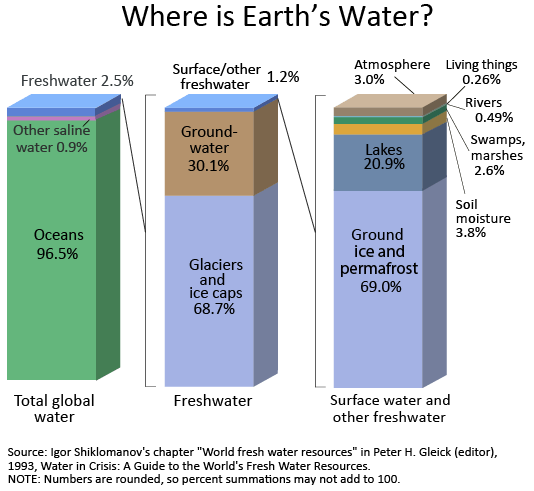Depending on your geographic location acquiring water could be very difficult or extremely easy. Sixty seven percent of the Earth's surface is covered with undrinkable saltwater. Fresh water ponds, lakes, streams, and rivers that are contaminated with microorganisms and pollutants total three percent of surface water. Identifying the location of streams, springs or other water source should be major part of your preparedness plans.
Identifying Potential Water Sources
Surface Water
Surface water may not be immediately visible, especially in rugged or obscured terrain. Abundance of lush green vegetation, particularly if surrounded by less-lush or arid areas. Look for drainage areas, downhill trends in the terrain and low ground. Animals can be an excellent indicator for the presence of water: "V" intersecting game trails, swarming insects, bird flights in the early morning or late afternoon, all might indicate a water source nearby. Even if the result of your search is a dry stream or pond bed, do not give up. Such areas may contain pockets of water under overhangs of vegetatation and rocks. Explore thoroughly. Failing surface water, such areas may be candidates for the extraction of subsurface ground water.
Do not try to use water that has floating material in it, water that has any odor, or water that has a dark color. These are all indications that the water is significantly contaminated and may be dangerous no matter what you do to filter it or kill bacteria.
Cold river water that is running is preferred over warm stationary water.
|
|
Plumbing Water
A considerable amount of water will be stored in your water pipes and related system. To get access to this water, first close the valve to the outside as soon as possible. This will prevent the water from running out as pressure to the entire system drops and prevent contaminated water from entering your house. Then open a faucet on the top floor. This will let air into the system so a vacuum doesn't hold the water in. Next, you can open a faucet in the basement. Gravity should allow the water in your pipes to run out the open faucet. You can repeat this procedure for both hot and cold systems.
Your hot water heater will also have plenty of water inside it. You can access this water from the valve on the bottom. Again, you may need to open a faucet somewhere else in the house to ensure a smooth flow of water. Sediment often collects in the bottom of a hot water heater. While a good maintenance program can prevent this, it should not be dangerous. Simply allow any stirred up dirt to again drift to the bottom.
|

